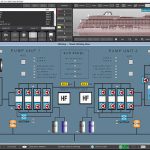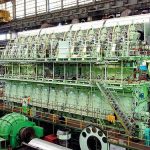Marine fuels and fuel handling are a common part of a ship’s engineers routine from taking on bunkers to ensuring the fuel is kept at optimum temperature, and as free from contaminates as possible, for use in the main engines or boilers.
The heavy fuel oil (HFO) used by our ship’s main engines and boilers is a viscous tarry substance; very high in sulfur so when combusted in a diesel engine large quantities of sulfur oxide/dioxide along with nitrogen oxides and particulates are produced.
By using the links in the following sections, the methods used for treating and storage of the HFO are explained. We begin with the origins of the heavy fuel oil.
The Production and Processing of Heavy Fuel Oil
Heavy fuel oil, or residual oil as it is also known, is a by-product of the refining of crude oil produced from oil wells/reservoirs both on and offshore.
Offshore, the oil is brought to the oil production platform through risers that connect the reservoir to the platforms. Here it is filtered to remove sand and grit before being pumped through various separators that remove the inherent gas and water. It is then heated and pumped ashore using sub-sea pipelines.
Once at the crude oil refinery, it is processed to remove any remaining water/salts before being heated to over 650°F and passed into a vertical distillation column. Here the various fractions are drawn off, leaving a tarry residue at the bottom of the column. It is here the HFO is drawn off for distribution to ships bunkers that after further on-board treatment use it as engine or boiler fuel.
Recent rules and annexes by the International Maritime Organization (IMO) and MARPOL 73/78 have capped the sulfur content of HFO to 4.5%, being further reduced to 3.5% next year. These “bottoms” therefore have to be further processed by de-sulfurization to reduce the sulfur level to within these limits.
Supply and Storage of Heavy Fuel Oil in Ship’s Bunkers
As we have seen, the HFO is produced at the crude oil refinery and transported by fuel tanker to the various port loading/storage facilities. From here it can be supplied directly into ships bunkers or pumped to bunker barges with the ships being supplied from these bunker barges while lying at anchor.
When I was an engineer at sea, one of my duties was to oversee the loading of HFO to the bunkers after a sample was checked by the Chief Engineer) and taking ullages (sounding the tanks) to ensure we were getting the amount ordered and paid for. In those days the heavy fuel oil was black as tar, being very high in contaminates. I am sure a few solutions were added to the oil by unscrupulous suppliers such as used engine oil, scavenge drains, and sludge tank contents. Anyway, nowadays there are stricter checks and rules governing the quality of supply of HFO to ship’s bunkers.
Treatment of Heavy Fuel Oil aboard Ship
Once the HFO has been loaded in the bunkers, steam is supplied to the heating coils to prevent the oil from becoming waxy. It is supplied from the bunkers daily to the setting tanks, where again optimum temperatures are maintained as the solids are allowed to settle out.
The oil is then processed further through various heaters, filters, clarifiers, and purifiers. Eventually it is supplied to the fuel pumps/common rail injection system on the main engine.
Main Engine Fuel Components
In my day at sea as a ship’s engineer, we had most of the components in the fuel systems that are used in today’s modern, more efficient engines. These were the fore-runners of the new components that have helped to raise the thermal efficiency of the marine diesel engine to over 50%
Effects of Fuel Oil Quality
The undesirable effects of fuel oil quality are passed onto the diesel engine causing at the least, a reduction in efficiency due to viscosity and poor combustion. There can also be serious effects such as corrosion and scavenge fires.
Authors Note
Although I retired from the sea many years ago, the experience and knowledge gained whilst sailing as an engineer is still as relevant now as it was over 40 years ago. Modern marine diesel engines are electronically managed and super-efficient. Their exhaust gas emissions have become much less polluting due to heavy fuel oil treatment both at the crude oil refinery and on board.
I hope the information given in the preceding sections is useful to today’s young engineers who may be starting on their career as marine engineers or studying for their relevant engineer certificates. Good luck to you all.


